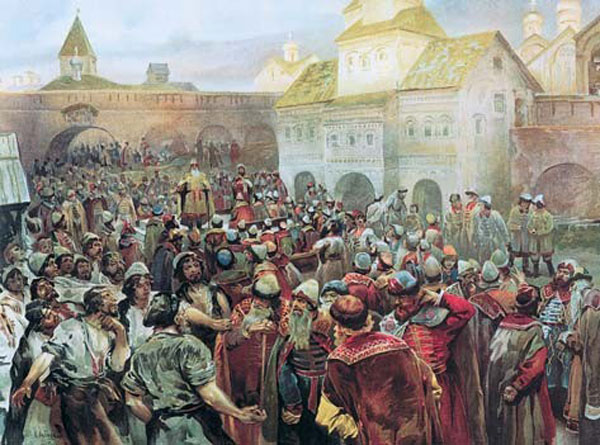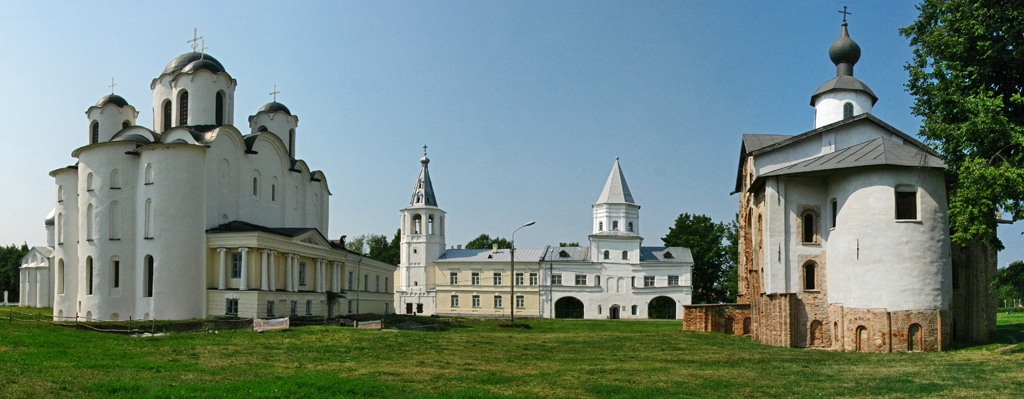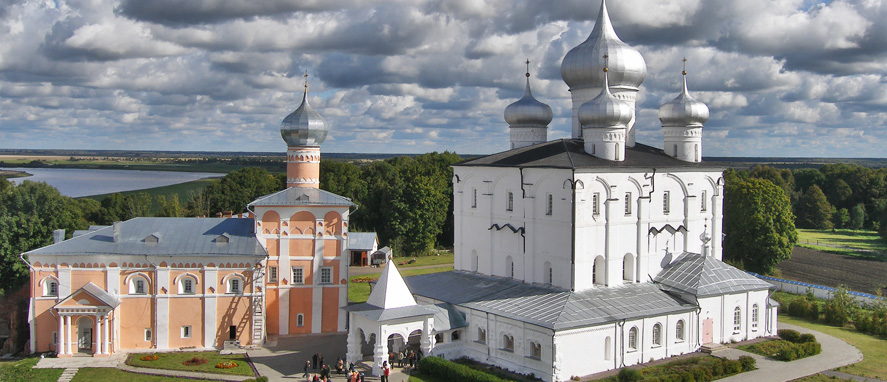Задание №9029.
Чтение. ЕГЭ по английскому
Прочитайте текст и заполните пропуски A — F частями предложений, обозначенными цифрами 1 — 7. Одна из частей в списке 1—7 лишняя.
Veliky Novgorod
Veliky Novgorod, one of the most ancient cities of Russia, was founded in the 9-10th centuries. Veliky Novgorod was a political centre of vast territories stretching up from Baltic lands to the Urals. For a long time the city had been the largest centre of culture in Russia, ___ (A). Many outstanding monuments of medieval architecture and painting have been preserved in the city.
The Kremlin is one of the most popular sights. It was built in 1044 by order of Prince Jaroslav the Wise. It is surrounded by a wall 1487 metres long. It once had 12 towers, ___ (B). The particular characteristic of the Kremlin is a large number of churches on the area. The architecture represents the style of the 15th century. The area around the Kremlin is very well-kept ___ (C). From the bastions one will have a wonderful view over the whole city.
The outdoor Vitoslavlitsy Museum of Folk Wooden Architecture is a haven to the people ___ (D) with massive skyscrapers, business centres and shopping malls. The museum presents some excellent examples of wooden structures from different parts and suburbs of Veliky Novgorod. The scenery here is so quiet ___ (E) and will just enjoy the stunning view of the Russian village.
The visit to the city helps to get acquainted with the history and the way of life of common country folk ___ (F) in different times.
1. and has a lot of green places
2. but now only 9 of them still exist
3. that they are protected by the state
4. where chronicles and books were created
5. who are tired of modern urban architecture
6. that one will easily forget about all the troubles
7. who lived on the territory of Novgorod principality
| A | B | C | D | E | F |
Решение:
Пропуску A соответствует часть текста под номером 4.
Пропуску B соответствует часть текста под номером 2.
Пропуску C соответствует часть текста под номером 1.
Пропуску D соответствует часть текста под номером 5.
Пропуску E соответствует часть текста под номером 6.
Пропуску F соответствует часть текста под номером 7.
Показать ответ
Источник: ФИПИ. Открытый банк тестовых заданий
Сообщить об ошибке
Тест с похожими заданиями
Velikiy Novgorod
Veliky Novgorod, one of the most ancient cities of Russia, was founded in the 9-10 centuries. Throughout many centuries, Novgorod was a political center of vast territories stretching up from Baltic lands to the Urals Mountains. For a long time, Veliky Novgorod had been the largest center of culture in Russia, where chronicles, books, hagiographies, deductive literature were created. Many outstanding monuments of medieval architecture and painting have been preserved in the city. The outdoor Vitoslavlitsy museum of wooden architecture presents some excellent examples of wooden structures from different parts and suburbs of Novgorod. The visit to Novgorod helps to get acquainted with the everyday life of the Russian people, who lived on the territory of Novgorod principality at different times.
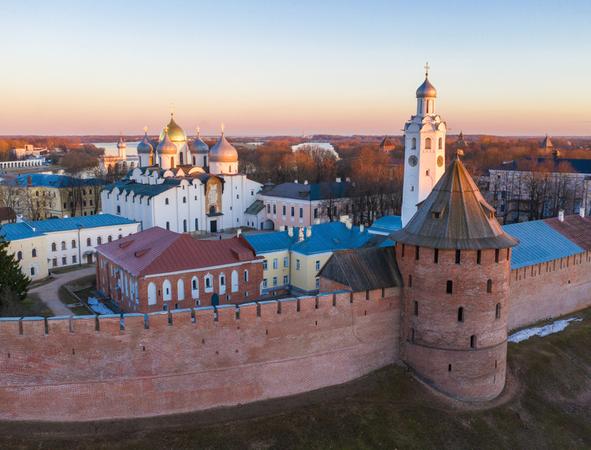
Velikiy Novgorod Day Tour
- 1 day
- 1 city
explore
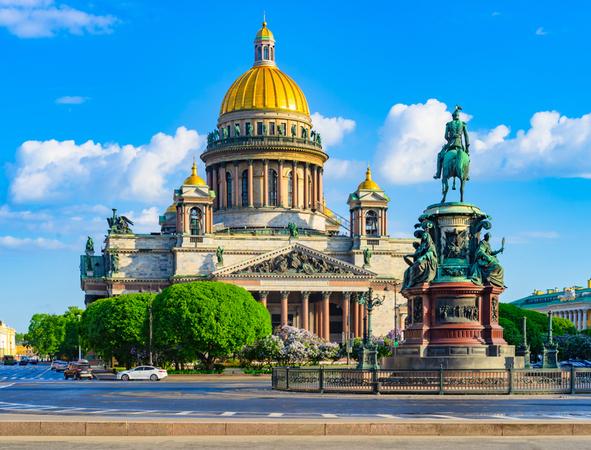
Saint Petersburg with the visit of Velikiy Novgorod
- 6 days
- 2 cities
explore
We use cookies to improve your experience on our Website, tailor content, and measure advertising. By continuing to use our Website, you accept our Privacy Policy.
—
Welcome to Velikiy Novgorod
General information
Velikiy Novgorod — one of the most ancient cities of Russia located in its North-West, near the site where the Volkhov river takes its waters from Lake Ilmen, emerged as a political center of Slavic and Fino-Ugric tribes in the mid-9th century, while as a town it was formed in the middle of the 10th century.

Alexander Nevsky Embankment
The history of Novgorod is closely linked with all major stages in the life of the Russian state. In those times, when the statehood of Rus was just in the making, the Novgorodians invited Scandinavian prince Rurik to keep law and order, thus giving birth to the prince Rurik dynasty that ruled over all Russian lands throughout more than 750 years.
St. Sophia Cathedral 1045 — 1050
In the early 10th century, war campaigns of the Novgorodians against Constantinople to secure equal trade with Bizantine resulted in the integration of East Slavic tribes into the ancient Kievan Russian state.

Fresco «Apostle Peter»
The adoption of Christianity at the close of the tenth century turned Novgorod into a powerful ecclesiastical center. The efforts of Novgorod Bishops in spreading and promoting the Orthodoxy were given high credit in the mid-12th century when they were elevated to the ranks of Archbishops which made the Bishops Chair of Novgorod the most powerful in the Russian Orthodoxy.

Monument to the Millenium of Russia
The right of Novgorod to select its own princes, that was granted in the middle of the twelfth century, attracted princes to the Novgorod throne. This provided favorable conditions to maintain the unity of Russian lands tending to be feudally divided, while the annexation of the Novgorod republic to the Moscow Principality at the end of the 15th century resulted in the united Russian State with Moscow as the capital.
Throughout many centuries, Novgorod was a political center of vast territories stretching up from the Baltic lands and Finland in the West to the northern Urals in the East. It was also one of the greatest international trade centers on the Baltic-Volga commercial route that tied northern Europe with Asia as early as the mid — 8th century.

Kremlin Intercession Tower. 16th 17th cc.
Novgorod is the cradle of Russian republican and democratic traditions. In the course of over 600 years, up till 1478, all vital decisions on its life and foreign policy were taken by the «veche» — an ancient parliament comprising the representatives of the town aristocracy families. At crucial times of Novgorod’s history, every citizen took part in the veche.
The republic’s special political structure, spiritual freedom and territorial independence were highly favorable to the evolution of culture and art.
Novgorod was one of Russia’s major centers of literacy and book production. As far back as in the 30-s of the 11th century, by the will of the great Prince Yaroslav The Wise, Novgorod saw the first school to train three hundred children at a time.
Medieval Novgorod was one of the greatest art centers of Europe. Its architectural traditions, school of icon-painting, jeweler’s and decorative applied art became famous all over the world.
Church of Our Saviour on Nereditsa
The town’s military power, its remoteness from dangerous southern borders, successful campaigns against clergical reforms and heresies enabled the city to preserve a unique complex of architectural monuments with frescoes of the 11th — 17th centuries, the oldest Russian manuscripts, chronicles, acts, icons. The only time in its history when Novgorod suffered military damages was in the course of World War II: for over two years the city, being at the front line, was bombed and shelled by both combating armies. Turned into ruins, this city on the Volkhov River was brought to life again by the restorers who managed to revive the old architecture. Welcome to Novgorod! You will be able to visit a unique complex of ancient Russian architectural monuments of the 11th — 17th centuries.

Fresco «St. Ustinia» (church of Our Saviour on Nereditsa)
First of all you will be fascinated by the cathedral of St. Sophia, the Holy Wisdom of God — the oldest surviving Russian stone monument. It was built in 1045. The powerful monolithic massive structure of the monument still dominates not only the Kremlin, but the whole historic downtown of Novgorod. In the interior of this palladion your attention will be drawn by the unique historically formed iconostases, ancient mural paintings, icons — national relics of Russia (including the famous icon of the 12th century — Virgin of the Sign, that was returned back to the cathedral in 1991, when divine services were resumed here), and other relics of Byzantine, Western Europe and Russian art. In the course of hundreds of years the Cathedral of St. Sophia was a center of the clergical, political and cultural life of ancient Novgorod.

You are welcome to admire the monuments of twelfth century Novgorod architecture — the Cathedral of St. Nicholas in Yaroslav’s Court and the Church of the Nativity of Our Lady in St. Anthony’s Monastery, that have brought to us old fresco painting, carved iconostases, and the necropolis of the 17th — 18th centuries. In the old cloister — the St. George (Yuriev) Monastery, that was founded as early as in the 12th century by Prince Yaroslav the Wise, as a legend reads, one cannot help being amazed by the striking beauty of another masterpiece of ancient Russian architecture — the Cathedral of St. George, built by a certain master mason Peter in 1119.

Archaeological finds from the Museum
Many experts of Russian art justly believe Novgorod to be a Russian Florence; no other old Russian cities have managed to preserve so many ancient architectural monuments adorned with wall murals. You will see that with your own eyes visiting the churches of Our Saviour on Nereditsa Hill and Annunciation of Our Lady on Miachino Lake (12th century): appreciating at its true worth the 14th century frescoes of world-famous Theophanes the Greek in the church of the Transfiguration of Our Saviour on Iliah Street; singularly graceful murals in the churches of the Nativity of Our Lady on Krasnoye Field, St. Theodore Stratilates on the Brook, admiring the beautiful clergical wall calendar of the 15th — 17th centuries in the Church of St. Simeon The Godreceiver: and studying wonderful mural compositions of the late 17th — early 18th centuries in The Virgin of The Sign Cathedral.

Great St. Sophia Zion.
You will, no doubt, be happy with a visit of the Kremlin of Novgorod — the oldest in Russia. This fortress was mentioned in chronicles as early as 1044. The present walls and towers were constructed at the close of the 15th century. The Detinets (that was the original name of the citadel ) was closely related to all the most important events in the life of ancient Novgorod: hosting foreign embassies, seeing-off warriors to fight the enemy, convening veche meetings. In addition to the above-mentioned St. Sophia’s Cathedral, the Kremlin also features such other striking monuments as the Faceted (Archbishop’s) Palace — a rare specimen of Gothic architecture, built in 1433 jointly with German masters, as well as the impressive and beautiful St. Sophia’s Bellfry of 1439 with a set of bells dating back to the 16th — 18th cc.

Icon «St. Nicolas»
In the central square of the Kremlin stands the monument «The Millenium of Russia», designed by Mikhail Mikeshin and erected in 1862. This unique document in bronze immortalizes all those who greatly contributed (in addition to the outstanding Russian politicians) to the development of the country: its culture, science, art, literacy, and literature. Leaving the Kremlin and St. Sophia Quarter of the city, you can get to the opposite bank of the Volkhov by a footbridge. Now we approach the territory of another architectural open-air museum: the Yaroslav’s Court and ancient Trade-yard, displaying many still-standing monuments of the 12th — 16th centuries: churches of St. John-The Baptist, Paraskeva-Pyatnitsa, Myrrh-Bearing Women and others — all reminiscent of the busy trade life of Novgorod in days goneby. Yaroslav Court, with its non-suviving wooden palace of Great Prince Yaroslav The Wise, was widely known since the middle of the 8th century as a site of the international Trade-yard, the oldest in northern Europe.

Wrap «Wirgin of the Sign with Selected Saints»

Shroud of Christ «Entombment». 15th c.
A visit to Novgorod usually leaves guests with unforgettable impressions of the inimitable and majestic Novgorod landscape. There are may enchanting sights on the boat tour of Lake Ilmen and the Volkhov river: Peryn — the site of the pre-Christian heathen temple; visiting Lipno island with one of the few preserved architectural specimens of the 13th century — the Church of St. Nicholas, decorated with frescoes of the same period.

Panagirion. 15th c. (Palace of Facets)
You are always welcome at the expositions and exhibitions of one of the most ancient and richest museums of Russia — Novgorod State United Museum, that offers visitors a unique collection of historic, cultural and art relics.

St. George Cathedral. 12th c. Yuriev Monastery
Of a special interest is the Museum’s archaeological collection, comprising all relics excavated from the soil of Novgorod in the archaeological research that has been carried out for more than 60 years. The archaeological finds include such world-famous items as a great number of birch-bark scrolls and lead seals dating back to the 12th — 15th centuries. These are indicative of a unique and striking (for medieval times) level of literacy among ancient Russians and also of a highly organized system of state control. The unprecedented rich collection of archaeological relics provides a basis for one of the best Russian historic expositions — the one called «Great Novgorod. Policy. Economy. Culture. 10th — 15th centuries «. It is displayed in the Kremlin’s former

Yuriev Monastery
world-famous Novgorod Museum collection of Novgorod school of icon painting covering the 12th — 15th centuries. This can only be thoroughly studied in Novgorod. Not even Moscow or St. Petersburg has this quality of subject matter. A suite of rooms on the second floor of the museum contains the artworks that can be studied.

Virgin of Sign Cathedral. Late 17th c.
It is also only in Novgorod that visitors can admire a unique collection of facial and ornamental embroidery of the 16th — 17th centuries. Exhibited in the Kremlin’s St. Ioann building, it features such wonderful works of ancient Russian embroideries as maniples of St. Varlaam of Khutyn (12th c.), shroud, commissioned by Dmitry Shemyaka (15th c.), omophorion of Nicon (17th c.), etc.
Of no less interest is the exhibition of ancient jewelry and decorative-applied art of the 10th to early 20th centuries, which is on display in the main hall of the Faceted (Archbishop’s) Palace of the Kremlin. Many of them are indeed unique: Zions from St. Sophia vestry (12th century), Craters of the 12th century, cloisonne enamels (10th — 12th centuries), panagiarion from the vestry of St. Sophia Cathedral (15th century), panagia of Archbishop Pimen (16th century).

Yaroslav’s Court and Ancient Torg
The open-air architectural-ethnographic museum «Vitoslavlitsy» provides a whole complex of genuine folk wooden architecture, including ancient churches of the 16th — 18th centuries and peasant houses of the 19th — early 20th centuries, exhibitions of folk art and everyday life items of Novgorod peasants of the same period.
Veliky Novgorod is one of the oldest cities in Russia. The town is located on the picturesque banks of the river Volkhov. Novgorod was first mentioned in chronicles in 859. Scientists consider that this is the date of its founding. In those days, it was called Новый город (New town). These two words put together gave the name of Novgorod.
Novgorod played a significant role in the history of ancient Russia. The West criticise today’s Russia for its lack of democratic ideals, but in Novgorod, at the beginning of the last millennium, this form of direct democracy, or вече (a popular assembly of men on the main square of the city to decide the urgent problems of the city’s administration and its protection) was normal. Regardless of the social status and wealth, everyone had the same right to vote. Because a hundred years ago Veliky Novgorod had a great authority in Ancient Russia, the town was called Господин Великий Новгород (Lord Novgorod the Great).
If you need to reach the highest results in the Russian language learning. In the shortest period of time you definitely need one of our
Intensive courses to learn Russian. To make the program more Intensive you may add additional individual hours to learn Russian language to the group classes and form Mixed program. During
the individual lessons Russian learning you will be able to ask all the questions, remained from the group classes, discuss with the teacher your homework and fill all the gaps in the Russian language knowledge you have ever had.
In the end of the 13th century and until the early 16th century, Novgorod was one of the greatest centres of Ancient Russia. Now Novgorod is a big modern city. But it is also a city-museum, in which have been preserved ancient architectural monuments until today. The heart of the city is the Kremlin of Novgorod. On its territory stands ancient monuments: St. Sophia Cathedral, a monument from the 11th century, and churches from the 12th to 16th centuries. In the centre of the Kremlin we can see a monument of the second half of the 19th century “the Millennium of Russia”.
Wonderful monuments of Russian architecture have reached our time through 10 centuries of wind, rain and frost. Today, ancient Orthodox churches can be seen everywhere in the city centre. They can stand very close from each others, only separated by few meters.
The city was severely damaged during WWII. Now it is difficult to believe that this beautiful city has reborn from ruins. Priceless monuments of the culture of ancient Russian has been restored.
And later, a unique museum of wooden architecture opened its doors near the city centre. There can be found original monuments of architecture brought from the Northern regions of Russia. So if you haven’t the chance to visit the legendary island of Kizhi in the Northern Republic of Karelia, the visit of the museum of architecture in Novgorod is a good alternative.
Thousands of people who are interested in ancient Russian cities, attend to Novgorod every year. Artists and architects learn from the old Russian masters. The welcoming land of Novgorod is offering its wealth to the visitors.
Евгения Плещунова
The famous Russian city Veliky Novgorod is situated by the Volkhov River, not far from Lake Ilmen. It is the birthplace of Russian democracy, the first Russian republic and the new state — Russia. For the first time it was mentioned in the chronicle in 859.
The centre of international trade and handicrafts.Veliky Novgorod has been always playing a crucial role in the trade of the country. It had joined the Hanseatic trade league even before Peter I made a decision to “cut a window to Europe”. Local craftsmen succeeded in different spheres. They used stones as a construction material in order to pave streets. They also provided the city with the plumbing and sanitary system that was very similar to modern ones. By the way, Veliky Novgorod got plumbed earlier than Paris, London and other capitals.
Veliky Novgorod — the museum of Ancient Rus’. You can hardly find any other Russian city that can boast such a large number of ancient churches and temples, as well as outstanding cultural sites included in the UNESCO World Heritage List. Veliky Novgorod was not affected by the Mongolian and Turkish invasion. The finest samples of architecture and painting are concentrated in this city. It is one of the largest centres of Russian civilization. Novgorod Kremlin built of red bricks was the first fortress within the territory of modern Russia. The Palace of the Facets, famous all around the world, was the first Russian Gothic building. The decree stating that the Novgorod Republic had joined the Grand Principality of Moscow was announced here.
Veliky Novgorod — the pioneer of literacy in Rus’. As the pioneer of literacy in Rus’, Veliky Novgorod got the large library as early as in the medieval times. Medieval birch bark manuscripts survived to this day. The first Russian books and multiple manuscripts were stored there. According to historians, Veliky Novgorod had been built before Rus’ was established. The Cathedral of St. Sophia was the birthplace of chronicle writing in Rus’.
Orthodox Christianity in Veliky Novgorod. Every year, thousands of pilgrims from all around Russia and from abroad come to this city in order to visit Christian sacred places. The Novgorod Diocese was established more than 1000 years ago. One of its masterpieces is the Church of the Transfiguration of the Savior. It was painted by the very talented artist from the Byzantine Empire — Theophanes the Greek. It was the first work which he created in Rus’. Besides, the Cathedral of St. Sophia in Novgorod was the oldest church in Rus’.
Veliky Novgorod — the custodian of the authentic Russian culture. It is the only place where you can listen to traditional gulsli and fipple flute playing and enjoy famous Novgorod shchi from grey hash cooked in the Russian stove.
Sign up for CONSTRUCTOUR!
Открыть всю книгу
Veliky Novgorod is the most important city of North-Western Russia and the administrative centre of Novgorod Oblast. The city lies along the Volkhov River just below its outflow from Lake Ilmen.
Novgorod was the second main city after Kiev in Russia in the mid centuries. It was a rich and powerful city, and the State of Novgorod was as large as the present Sweden. Its power was based on the international trade. Novgorod was the main Russian port for many centuries and was important for Baltic Sea trade.
Nowadays, Veliky Novgorod is a small, calm town in the provinces, with splendid old Russian architecture, interesting museums, fresh air, many trees, and nice and helpful people. I like this town very much. I like the people there.
In 2009, Novgorod marked 1150 years since it was first mentioned in 859 in the most ancient national texts — the Russian Primary Chronicles. The event was granted national status and was organized with the participation of the Russian President and the Federal Government. The celebration lasted for a whole week. The programme was filled with performances, exhibitions, and fairs. A fireworks and laser show brought huge crowds to the Volkhov River on Saturday and Sunday nights. Skydivers and a show by vintage planes graced the skies over the river area on Sunday. Many of these events were covered by news media and shown on TV.
Открыть всю книгу
1.
Novgorod (Newtown) is one of the most ancient cities in Russia. The
town was founded by Prince Yuri Dolgoruki in the 10th
century, near the Volkhov river and Lake IImen. It later became the
Centre of the independent Novgorod Republic.
2.
In medieval times, Novgorod was one of the greatest art centres in
Europe. Its architecture, jewellery, painted icons and decorative art
became famous all over the world. In the 1100s, Prince Yaroslav the
Wise opened the first school in the city. Documents written on
birch-bark, found by archaeologists, prove that the citizens of
Novgorod had a high level of literacy and culture.
3.
Novgorod’s good geographical position meant that the city was able
to establish economic and cultural links with Western Europe. It
became a go-between in the trade of Europe with oriental countries.
4.
Novgorod is connected with many great people. One of these people is
Alexander Nevsky, the famous prince of Novgorod who defeated the
Swedes and defended Russia in the 13th
century. After this victory, he was given the nickname ‘Nevsky’
because the battle had taken place on the Neva river.
5.
Visitors to Novgorod will be fascinated by the cathedral of St.
Sophia, the oldest surviving stone monument in Russia, built in 1045,
and the Kremlin of Novgorod, which is Russia’s oldest Kremlin. You
can also visit a unique complex of ancient Russian architectural
monuments from the 11th
to 17th
centuries. Novgorod is a beautiful town, full of history and culture.
8.
Read the text again and match the paragraphs to the headings.
History □
Trade □
Famous
Citizens □
Novgorod
Today □
Art
and Education □
9.
What do these numbers in the text stand for?
10th
century, 13th
century, 1100, 1045
10.
Speaking.
In pairs, ask and answer questions about Novgorod.
11.
Read the text “The Golden Ring” and say what you think the Golden
Ring is. Have you been to any of the towns of the Golden Ring?
The
Golden Ring is a group of ancient Russian towns and cities that form
a curved line that begins and ends in Moscow. These towns and cities
are an important part of Russian culture as they are places that have
seen the main events of Russian history. A tour of the Golden Ring
gives visitors the opportunity to learn about Russia’s past,
culture and traditions.
VLADIMIR
– Vladimir was founded by Prince Vladimir Monomach in 1108 and
became the capital of North-Eastern Russia in the 12th
century. It is famous for its beautiful architecture and its peaceful
atmosphere.
SUZDAL
– Suzdal was established in 1024 and is one of the best-preserved
towns in Russia. Visitors will see building styles from different
epochs and will enjoy exploring the city on foot. If you like
camping, you can pitch your tent on the banks of the river Kamenka.
KOSTROMA
– Founded in 1152 and located on the Volga River, Kostroma was the
birthplace of the Romanov Dynasty. It is well known for its
Fire-Watch tower and the Church of the Resurrection.
YAROSLAVL
– This town was founded at the beginning of the 11th
century (1010) in the place where the Volga and Kotorosl rivers meet.
The city has wonderful architecture and a heroic past. One of the
main tourist attractions of this town is the Monastery of the
Transfiguration of the Saviour.
ROSTOV
THE GREAT – Founded in 862, this ancient Russian town is located on
lake Nero. The Rostov Kremlin, the Cathedral of Assumption and the
Bell Tower will impress visitors. The largest of the Rostov bells
weighs 32,000 kg and the sound of its chimes can be heard for 20km!
PERESLAVL-ZALESSKY
– Established in 1152 and halfway between Moscow and Yaroslavl, on
the bank of the Pleshcheevo Lake is Pereslavl-Zalessky. In 1693 Peter
the Great constructed a prototype of the first Russian fleet here.
Now the lake has National Park status.
SERGIEV
POSAD – Founded in 862 and named after Saint Serguis who founded
the largest Russian monastery, The Holy Trinity – St. Sergius
Lavra. The monastery contains a huge library of religious books as
well as icons and other treasures.
12.
Read the text again and mark the sentences T (true) or F (false).
Then correct the false statements.
1.
Vladimir was founded by Prince
Vladimir
Monomach and became the capital
of
South-Eastern Russia in the 12th
century. …………
2.
Suzdal is a great place to visit if you
like
walking.
…………
3.
Kostroma is situated where three rivers
join
together.
..……….
4.
Lake Nero has National Park status.
…………
5.
Peter the Great founded a library of religious
books
at the largest monastery in Russia. …………
13.
Match the place with the description.
|
1.
2.
3.
4. history 5. |
Kostroma Vladimir Suzdal
Rostov Pereslavl-Zalessky |
14.
In pairs, ask and answer questions about the towns in the Golden
Ring.
Соседние файлы в предмете [НЕСОРТИРОВАННОЕ]
- #
18.04.2015241.15 Кб411.doc
- #
- #
- #
- #
- #
- #
- #
- #
- #
- #




